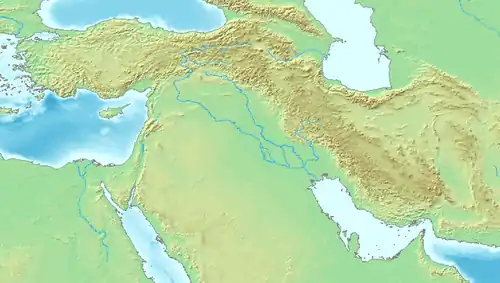Nahal Me'arot Nature Reserve
The Caves of Nahal Me’arot / Wadi el-Mughara ("Caves Creek"), named here by the Hebrew and Arabic name of the valley where they are located, are a UNESCO Site of Human Evolution in the Carmel mountain range near Haifa in northern Israel.[1][2]
| UNESCO World Heritage Site | |
|---|---|
 | |
| Official name | Sites of Human Evolution at Mount Carmel: The Nahal Me’arot / Wadi el‑Mughara Caves |
| Location | Mount Carmel, Israel |
| Criteria | Cultural: (iii), (v) |
| Reference | 1393 |
| Inscription | 2012 (36th session) |
| Area | 54 ha (130 acres) |
| Buffer zone | 370 ha (910 acres) |
| Coordinates | 32°40′12″N 34°57′55″E |
 Location of Nahal Me'arot Nature Reserve in Near East  Nahal Me'arot Nature Reserve (Israel) | |
The four UNESCO-listed caves are:
- Tabun Cave or Tanur Cave (lit.: "Oven")
- Gamal Cave or el-Jamal ("Camel")
- el-Wad Cave or Nahal Cave ("Stream")
- Es-Skhul Cave or Gedi Cave ("Kid")
The four caves were proclaimed a site of "outstanding universal value" by UNESCO[1] in 2012. They are protected within a nature reserve.[2]
The caves were used for habitation by hominins and prehistoric humans and contain unique evidence of very early burials, at the archaeological site of el-Wad Cave in the Nahal Me'arot Nature Reserve.
Gallery
 A Paleolithic reconstitution in Jamal Cave
A Paleolithic reconstitution in Jamal Cave Paleolithic tools in Jamal Cave (replica)
Paleolithic tools in Jamal Cave (replica) Entrance to el‑Wad Cave
Entrance to el‑Wad Cave.jpg.webp) Inside el‑Wad Cave
Inside el‑Wad Cave Excavation work in el‑Wad Cave's terrace
Excavation work in el‑Wad Cave's terrace El‑Wad point microlith
El‑Wad point microlith

See also
References
- UNESCO website
- "Nahal Me'arot Nature Reserve". Israel Nature and Parks Authority. Retrieved 31 December 2019.
External links
| Wikimedia Commons has media related to Nahal Mearot. |
- Official page at Israel Nature and Parks Authority website
- UNESCO: Sites of Human Evolution at Mount Carmel: The Nahal Me’arot / Wadi el-Mughara Caves
- Nahal Me'arot recognized as World Heritage Site
This article is issued from Wikipedia. The text is licensed under Creative Commons - Attribution - Sharealike. Additional terms may apply for the media files.